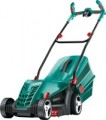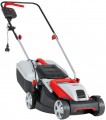Cutting width
The capture width provided by the unit, in other words, the width of the strip of land cultivated in one pass. In fact, this size corresponds to the width of the working nozzle.
The large working width is useful when processing large open spaces, as it allows you to finish the job in a small number of passes. On the other hand, for hard-to-reach places, relatively narrow tools are better suited, able to go where a wider unit will not fit. In addition, the width of the tool directly affects the weight and price.
In general, it makes sense to compare in terms of working width only units of the same type (see above). However, it is worth noting here that trimmers do not differ so much from each other — most models capture from 25 to 45 cm (and a wide processing band is provided by moving the nozzle from side to side). As for the other types, in the most modest models the capture width
does not exceed 40 cm, in the heaviest and most powerful it can be
56 – 60 cm or even
more(in mini tractors — up to 1.5 m).
Max. cutting height
The maximum cutting height that the lawn mower can achieve is the maximum height of grass that can be left after the machine has passed.
This parameter is relevant mainly for those cases when you want to leave the grass on the lawn relatively long. In addition,
lawn mowers with high cutting heights have a wide range of mowing adjustments.
Number of height settings
The number of cutting height settings provided by the lawn mower. The more such settings (with the same adjustment range) — the more accurately you can choose the mowing height. Note that in some robots (see "Type") this number reaches 30 or more with a range of 30 to 60 mm; in other words, you can select the height to the nearest millimetre.
Cutting height adjustment
The cutting height adjustment method provided in the machine.
—
Synchronous. Adjustment carried out "in one movement" — as opposed to the manual described below. In traditional lawn mowers, it is usually carried out by a lever that changes the height of all wheels at the same time; in other units, not the wheels, but the cutting tool itself, can be adjusted in height. Anyway, synchronous adjustment is much more convenient than manual adjustment, and for some devices (for example, robots and riders, see "Type") this is generally the only technically possible option. However, in classic mowers, such a system complicates and increases the cost of construction.
— Manual. The meaning of this type of adjustment depends on the type of device. So, for trimmers, this is almost the only possible way by definition: in them, the cutting height is regulated by how high the operator holds the working nozzle. In lawn mowers, manual adjustment means that you need to separately adjust the height of each axle, and even each individual wheel. Such systems are simpler and cheaper than synchronous systems, but less convenient to use.
Recommended area
The area of the site for which the lawn mower is designed. It cannot be argued that this parameter is critical when choosing a device, these are only manufacturer's recommendations and are very conditional. However, they are more than justified and generally show the available front of work based on the heating of the motor, the capacity of the tank or battery, and other factors that affect the duration of work.
Bag volume
The volume of the grass clipping bag supplied with the lawn mower. Manufacturers select this volume depending on the power, performance and overall level of the unit, however, similar models may differ in this indicator. In such cases, it is worth considering that a larger bag takes longer to fill and needs to be unloaded less often, but it weighs more and takes up more space (even when empty). Mostly the difference in the volume of the bag is 5 liters and there are
lawn mowers for 35,
40,
45,
50, 55,
60,
65,
70 and more liters.
Front wheel diameter
The diameter of the front wheels of the unit. For more information about this parameter, see "Rear wheel diameter" — everything written there is true in this case. We only note that the front wheels relatively rarely have their own drive, so the diameter for them is not as important as for the rear ones.
Rear wheel diameter
The diameter of the rear wheels of the unit.
Larger wheels, on the one hand, increase cross-country ability and allow you to effectively overcome pits, bumps and other obstacles on rough terrain. On the other hand, they cost more, are more expensive, and in self-propelled models, they also require more traction from the engine.
This indicator is often determined by the type of lawn mower (see above). So, mowers and riders, by definition, have large wheels, because they are designed for difficult terrain, and in a minitractor, the wheels must also withstand a fairly significant weight. But
robotic lawn mowers, on the contrary, are used mainly on flat surfaces with low grass, and they do not need large wheels.
If you have to choose among classic lawn mowers, where this parameter can be different, you should proceed from the planned working conditions. So, if we are talking about a flat lawn — you can not pay much attention to this indicator; but for rough terrain with pits, tubercles, ditches, etc., you should choose larger wheels — from 25 cm or more.
Noise level
The level of noise produced by the device during operation. Usually, a certain average indicator is indicated in the characteristics — in the standard mode of operation; however, the actual values usually do not differ much from the claimed ones.
The lower the noise level, the more convenient the unit to use and the less tired the operator. In the case of lawn mowers, this is especially true, since such equipment is quite noisy — even the quietest models (some robots) give out about 47 – 48 dB, which is comparable to talking at an average volume. Note that the decibel is a non-linear quantity, and it is easiest to evaluate the actual loudness using comparative tables. Here is the simplest table for the values found in modern lawn mowers:
— 60 – 65 dB — talking in raised tones at a distance of about 1 m;
70 dB — loud conversation of several people at the same distance;
75 dB — loud laughter at a distance of 1 m;
80 dB — motorcycle engine, medium power vacuum cleaner.
90 dB — loud screams, freight car at a distance of 7 – 10 m;
100 dB — a subway train or a loud car signal at a distance of 5 – 7 m, an industrial workshop;
110 dB — tractor engine at a distance of about 1 m.
In addition to subjective sensations, there are specific sanitary standards that limit the impact of strong noise. So, according to European standards, noise of 85 dB is allowed to be heard without protective equipment for 8 hours, 91 dB — 2 hours, 97...dB — half an hour, and 103 dB — only 7 minutes. So when choosing a unit, you should take into account the duration of work with it — with high noise, you may need protective headphones.

